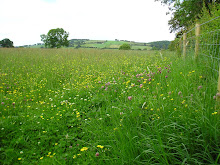

Our village magazine "Leintwardine Life" included reference to Himalayan Balsam growing by the river banks. Its an invasive plant outlawed by the Wildlife and Countryside Act because its such a bully. The bees don't agree! It provides them with a rich source of both pollen (protein for the larvae) and nectar (carbohydrate) just when they need it to start building winter stores.
I know that our bees have found it down by the river Clun because they have been returning looking as though they have been playing in a bag of flour. The pic shows a returning worker with the telltale white dusting.
It has been a busy Bank Holiday weekend for events including the Sun Inn beer festival. As I was peering into the bottom of my pint of Hobson's "Old Flossie" one of our local beekeepers, Robin, came over to discuss the current problem of wasps. Conversation was not easy thanks to the live music pulsating from the performance tent but we agreed that there are signs that the wasps may be a real problem this year unless we get some cold nights to start killing them off. Robin's bees are also bringing in the balsam.
Back at the hives I took a picture of an interloper trying her luck, unsuccesfully, at hive 2.






